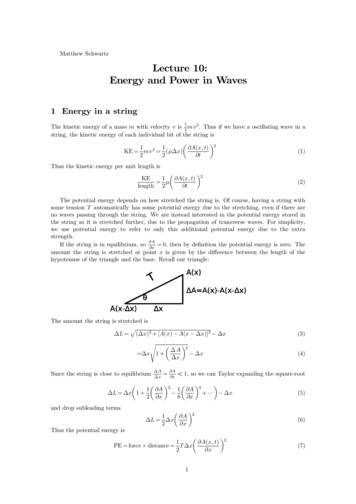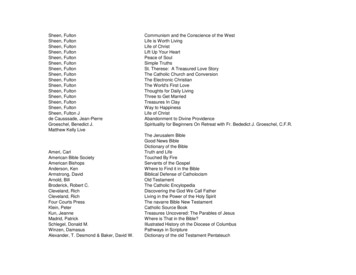
Transcription
Matthew SchwartzLecture 10:Energy and Power in Waves1 Energy in a string1The kinetic energy of a mass m with velocity v is 2 mv 2. Thus if we have a oscillating wave in astring, the kinetic energy of each individual bit of the string is 11 A(x, t) 2KE mv 2 (µ x)(1)22 tThus the kinetic energy per unit length is 1 A(x, t) 2KE µ tlength 2(2)The potential energy depends on how stretched the string is. Of course, having a string withsome tension T automatically has some potential energy due to the stretching, even if there areno waves passing through the string. We are instead interested in the potential energy stored inthe string as it is stretched further, due to the propagation of transverse waves. For simplicity,we use potential energy to refer to only this additional potential energy due to the extrastrength. AIf the string is in equilibrium, so x 0, then by definition the potential energy is zero. Theamount the string is stretched at point x is given by the difference between the length of thehypotenuse of the triangle and the base. Recall our triangle:The amount the string is stretched isp L ( x)2 [A(x) A(x x)]2 x xsSince the string is close to equilibrium1 A x A x A x 2 x(3)(4) 1, so we can Taylor expanding the square-root 1 A 2 1 A 4 L x 1 ··· x2 x8 x(5)and drop subleading terms A 21 L x x2(6) 1 A(x, t) 2PE force distance T x2 x(7)Thus the potential energy is1
2Section 2And so 1 A(x, t) 2PE T xlength 2(8)Note that this is proportional to the first derivative squared, not the second derivative. Indeed, 2Aeven if there were no net force on the test mass at position x (so that x2 0), there would stillbe potential energy stored in the stretched string. Even though the wave is transverse, theenergy comes from stretching the string both longitudinally and transversely.So the total energy per unit length is 1 A 2 1 A 2Etot T(9) µ2 t xlength 2Now consider the special case of a traveling wave A(x, t) f (x vt). Then, A A v t xThus A x 2 1 A 2 µ A 2 2 tvT tSo the total energy per unit length for a traveling wave A 21 A 2 1 A 2Etot T µ µ2 t t xlength 2(10)(11)(12)Recalling that impedance for a string isZ forceT Tµ vµvelocity v(13)we can write the energy as EtotZ A 2 length v t(14)2 PowerAn extremely important quantity related to waves is power. We want to use waves to do things,such as transmit sound or light, or energy in a wire. Thus we want to know the rate at whichwork can be done using a wave. For example, if you have an incoming sound wave, how muchpower can be transmitted by the wave to a microphone?For an incoming traveling wave, let us return to this figureWe want to know how much power can be transmitted from the test mass at A(x x) to thetest mass at A(x). Now, power force velocity. But we don’t want the net force on A(x),only the force from the left to compute power transmitted. A AWe calculated that the force from the left is F T x . For x 0 this force pulls downward.To see the power transmitted, we need the force which moves the string away from equilibrium, Awhich is the upward force F T x . Then A(x, t) A(x, t)P F · v T(15) x t
3Sound intensity (decibels)For a traveling wave A(x, t) f (x vt) we can use Eq. (10) to write this as A(x, t) 2 A(x, t) 2 A(x, t) 2 vµ ZP vT t t x(16)The sign is for a right-moving wave (power goes to the right) and for a left-moving wave.Now recall that if we have a wave going from a medium with impedance Z1 into a mediumwith impedance Z2, the amplitude of the transmitted and reflective waves are related to theamplitude of the incoming wave byAT 2Z1AI ,Z1 Z2AR Z1 Z2AI ,Z1 Z2(17) 2(18)Thus if the power in the incoming wave is PI Z1 AI tThen the power in the reflected wave is Z1 Z2 AI 2Z1 Z2 2P R Z1 PIZ1 Z2 tZ1 Z2and the power in the transmitted wave is 2 2Z12Z1 AI 2 Z2 PIPT Z2Z1 Z1 Z2Z1 Z2 tThus, the fraction of power reflected is PRZ1 Z2 2 Z12 2Z1Z2 Z22 PI(Z1 Z2)2Z1 Z2and the fraction of power transmitted is 22Z14Z1Z2P T Z2 (Z1 Z2)2P I Z1 Z1 Z2Note thatPT PR 1PIso that, overall, power is conserved.(19)(20)(21)(22)(23)3 Sound intensity (decibels)PIntensity is defined as power per unit area: I A . Sound intensity is measured in decibels. Alogarithmic scale is used for sound intensity because human hearing is logarithmic. For example,if something has an intensity 1000 times larger, you will perceive it as being 3 times as loud.WDecibel is a logarithmic scale normalized so that 0 dB is 10 12 m . That is, by definition0 dB 10 12Watts I0meter2(24)A decibel is 1 tenth of a bel. The number of bels can be computed from a given intensity byloudness in bels 100 log10II0(25)The number of decibels is thereforeloudness in decibels 10 log10II0(26)
4Section 3Some reference intensities aresoundThreshold for human hearingBreathing at 3 metersRustling of leaves···Music at 1 metervacuum cleaner···rock concertthreshold for painjet engine at 30 metersdecibels010207080120130150Table 1. Reference decibel intensitiesIt is easy to compute the decibel intensity. For example, suppose you are 3 meters away froma 50 Watt speaker. Watts are a unit of power, so at 3 meters, the power is distributed across asphere of surface area A 4πr2. Thus, if all the power went into sound, the intensity would beI W50W 0.44 2m4π(3m) 2(27)Thus,WL 10log100.44 m2 116dBW10 12 m2(28)This is not actually how loud a speaker is (it’s more like the loudness of a rock concert). Inreality, the energy of the speaker is only transmitted into sound very inefficiently. We can definethe efficiency as the power coming out in sound divided by the power which the speaker drawsfrom the battery. The efficiency is around 10 5 for a typical speaker. So,WL 10log1010 50.44 m2W10 12 m2 66dB(29)The efficiency is so low because the speaker and the air have very different impedances.It takes about 150 mW of power to bow a violin and about 6mW of power comes out insound. So a violin has an efficiency of ε 0.04 4%. This is much greater than a speaker, butstill most of the energy used in bowing a violin is mechanical and not transmitted into sound.PHow does the loudness change with distance? Since I 4πr2 we haveL 10log10PP 10log10 20log10 r4πI04πr 2I0(30)Thus loudness only drops logarithmically with distance. Say you measure a loudness L0 at a distance r0. Then the loudness at a distance 2r0 would beL 10log10P 20log10 (2r0) L0 20log10 2 L0 6.0214πI0(31)That is, it’s 6 decibels lower.Or we can ask at what distance compared to r0 we should have to go for the loudness todrop by 10 decibels? That would be20log10r 10r0 r 3.162r0(32)
5Plane wavesSo if you go 3 times farther away, you are down by 10 decibels.4 Plane wavesThe waves will propagate in 3 dimensions, so we need the 3-dimensional version of the waveequation: 2 2 2 2 2 v A(x, y, z, t) 0(33) x2 y 2 z 2 t2This is the obvious generalization of the 1D wave equation. It is invariant under rotations of x,y and z (in fact, it is invariant under a larger group of symmetries, Lorentz transformations,which mix space and time).There are many solutions to this 3D wave equation. Important solutions are plane wavesA(x, y, z, t) A0cos k · x ωt φ (34)for some amplitude A0, frequency ω and fixed vector k called the wavevector. For a plane waveto satisfy the wave equation, its frequency and wavevector must be related byω v k(35)Thus norm of k is fixed by ω and v, but k can point in any direction. The direction k points isthe direction the plane wave is traveling. For example, if k (0, k, 0) the wave isA(x, y, z , t) A0cos(k (y vt) φ)(36)which is a wave traveling in the y direction with angular frequency ω k v. This plane wave isconstant in the x and z directions.Planes waves have direction and phase. Falstad’s ripple simulation (see link on isite) program gives a nice way to visualize waves. It shows the amplitude of the wave by different bycolors. Plane waves going in the y direction look like(37)cos(ky ωt)cos(ky ωt π)These are both plane waves, but they have different phases. These happen to be exactly out ofphase.Plane waves form a basis of all possible solutions to the wave equation. They are the normalmodes of the 3D wave equation. For each frequency ω there are plane waves in any direction kωwith k v with any possible phase.
6Section 5Another important feature of plane waves is that if you are far enough away from sources,everything reduces to a plane wave. For example, if we have some messy source in a cavity, thesolution to the wave equation might look likeInside the dashed box, the solution is very similar to the solution of the plane wave.How much power is in a plane wave? At a time t the part of the wave in Eq. (36) at positiony has power A 2 ZA20ω 2sin2(ky ωt φ)(38)P (t, y) Z tThis power is always positive but it oscillates from 0 to its maximum value as the wave oscillates. We don’t care so much about these fluctuations. A more useful quantity is the average2πpower. Averaging the power over a wavelength λ k giveshP i Pavg k2πZ02πk1dyP (t, y) Zω 2A202(39)where Z ρcs is the impedance for air. The average power is in principle a function of time. Inthe case of a plane wave, the average power is time-independent.5 InterferenceNow we are ready to discuss one of the most important concepts in waves (and perhaps all ofphysics) constructive and destructive interference.Suppose we have a speaker emitting sound a frequency ω. If the speaker is at y 0 it and weare at large enough distances, the sound will appear as a plane waveA1 A0cos(ωt ky φ1)(40)Now say we have another speaker directly behind the first speaker producing the same sound atthe same volume. We also find a plane wave solution are at large enough distances, the soundwill appear as a plane waveA2 A0cos(ωt ky φ2)(41)We know the frequencies are the same, and k is the same, but the phases can be different. Thetotal wave is thenAtot A1 A2 A0cos(ωt ky φ1) A0cos(ωt ky φ2) φ φ2 φ 2A0cos ωt ky 1cos22(42)(43)where φ φ1 φ2 is the phase difference. This last step is just some trigonometry, which youcan check by applying the Mathematica command TrigReduce[] to Eq. (43).
7InterferenceThus the average power is now1 1 222 φ2 φhP2i Zω (2A0) cos 4hP1icos222(44)where hP1i 2 Zω 2A20 is the average power from a single source.In a generic situation, say where multiple frequencies are produced by different uncorrelatedspeakers, the phases will have nothing to do with each other. Then, over time the phasediffer 12 φence can change and we should average the phase difference too. Replacing cosby 2 then2gives1hP2i 4hP1i 2hP1i(45)2So two speakers produce twice the power of one speaker. This makes perfect sense.Now suppose instead that the two speakers are exactly out of phase, so that φ π, we findhP2i 0(46)Thus no power is emitted. This is destructive interference. Conversely, if φ 0, thenhP2i 4hP1i(47)This is constructive interference. Thus two speakers working in phase can produce fourtimes the power of a single speaker.How is this possible? Where is the power coming from? If one looks at how much power isbeing drawn from the currents driving the speakers, will you find twice as much power is beingdrawn when the speakers are coherent as when they are incoherent? What is actually happeningis that one speaker is pushing down on the other speaker, forcing it to work harder. This iscalled source loading. Thus (in principle) more power is being used by the speakers. However,you won’t see this by looking at the power being drawn, since speakers are very inefficient – only0.01% of the power goes to sound. Instead, the source loading is actually making the speakermore efficient, so that more sound comes out with the same power.One way to get a produce two coherent speakers is having one speaker a distance d from awall:Figure 1. A source near a wall looks like two sourcesA wall has infinite impedance (Z2 ), so the sound will reflect off completely. Recall thatthe amplitude for a sound wave A(x, t) describes the longitudinal displacement at time t of molecules whose equilibrium position is at x. If A 0 is a displacement to the right, then when thewave reflects it will have A 0, since R 1. Thus the reflected wave will be displaced to theleft. Thus its displacement looks like the mirror image of what the displacement would be ifthere were no wall. Thus, at a point x there will be sound coming directly from the source and2πalso sound from the reflection. Say the angular frequency is ω and the wavelength is λ k v2π ω . What is the intensity picked up by a microphone a distance L from the wall?
8Section 5The easiest way to compute the effect of the reflection is using the method of images: thereflection will act exactly like a source a distance d on the other side of the wall. Far enoughfrom the source and the wall both the source and its image will produce plane waves. The original source is a distance d from the wall and so a distance L d from the microphone it producesA1 A0cos(ωt k (L d))(48)where we have set the φ 0 for the source for simplicity. Then the image source will produceThus the phase difference isA2 A0cos(ωt k (L d)) φ 2kd 4πdλ(49)(50)For d λ (the speaker is close to the wall), then φ 0 and we have complete constructiveinterference. Thus by putting a speaker near a wall we get four times the power. This iscalled a proximity resonance or self-amplification.You might have expected there to be twice the power. Since all the power is going into halfthe space, by conservation of energy this is perfectly logical. Indeed, if the source and the imagewere incoherent, there would be twice the power. However, we get another factor of 2 fromsource loading so in fact the power goes up by 4.It is natural to try to add more proximity resonances. For example, if we have 4 walls or a30% wedge we would getThis figure and caption are taken from Heller.With four walls, the area goes to one fourth the area, so naively you would expect a factor of4 increase in intensity. However, due to source loading the enhancement is a factor of 16. Trystanding near a corner and you can hear this yourself. For the 30 degree wedge, source loadinggives a factor of 144 enhancement. For a 30 degree wedge in 3 dimensions, the enhancement isaround a factor of 200.The amount of enhancement depends on the frequencies involved. When d λ there is asmuch destructive interference as constructive interference. Thus, there is no source loading orproximity resonances for high frequencies. One still gets the enhancement in intensity from confining the sound to a smaller volume, but this is not as dramatic as when source loading is relevant. When the size of the wedge is of order the distance to the source, boundary effects becomeimportant and one cannot use the plane wave approximations. You can play with numericalsolutions with arbitrary configurations using Falstad’s ripple.
Interference9
Energy and Power in Waves 1 Energy in a string The kinetic energy of a mass m with velocity v is 1 2 mv2. Thus if we have a oscillating wave in a string, the kinetic energy of each individual bit of the string is KE 1 2 mv2 1 2 (µ x) A(x,t) t 2 (1) Thus










